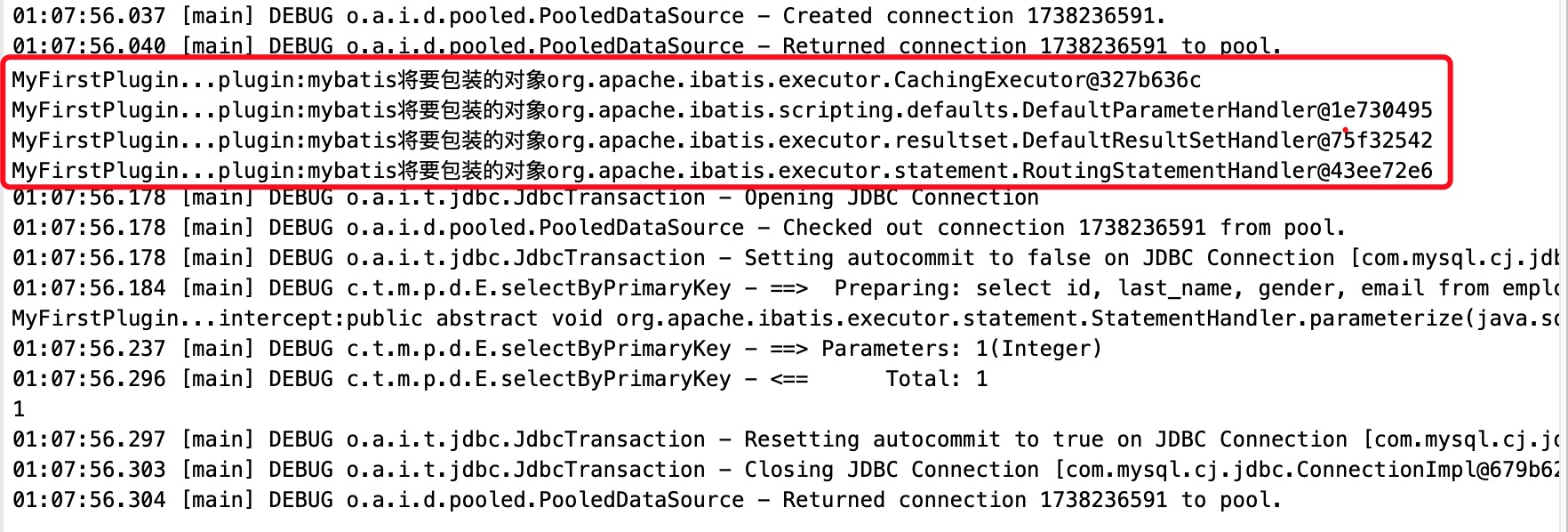MyBatis插件开发原理
MyBatis采用责任链模式,通过动态代理组织多个插件(拦截器),通过这些插件可以改变MyBatis的默认行为(诸如SQL重写之类的),由于插件会深入到MyBatis的核心,因此在编写自己的插件前最好了解下它的原理,以便写出安全高效的插件。
MyBatis在四大对象的创建过程中,都会有插件进行介入。插件可以利用动态代理机制一层层的包装目标对象,而实现目标对象在执行目标方法之前进行拦截的效果。
插件介入指的是:创建过程中都会涉及到调用interceptChain.pluginAll()方法对四大对象进行重新包装,返回一个代理对象。
MyBatis 允许在已映射语句执行过程中的某一点进行拦截调用,默认情况下,MyBatis 允许使用插件来拦截的方法调用包括:
1、拦截执行器的方法:Executor(update, query, flushStatements, commit, rollback, getTransaction, close, isClosed)
2、拦截参数的处理:ParameterHandler(getParameterObject, setParameters)
3、拦截结果集的处理:ResultSetHandler(handleResultSets, handleOutputParameters)
4、拦截Sql语法构建的处理:StatementHandler(prepare, parameterize, batch, update, query)
默认情况下,Mybatis允许使用插件来拦截的接口和方法包括以下几个:
插件开发是基于动态代理实现的,所有有必要对动态代理有所了解。
我们可以看一下MyBatis是怎么创建这四大接口对象的。找到源码BaseStatementHandler
1 this.parameterHandler = configuration.newParameterHandler(mappedStatement, parameterObject, boundSql); 2 this.resultSetHandler = configuration.newResultSetHandler(executor, mappedStatement, rowBounds, parameterHandler, resultHandler, boundSql);
进入configuration类,下面几处都是在创建newParameterHandler,ResultSetHandler,StatementHandler这几个对象,在调用的过程中,大家都看到了都使用了interceptorChain.pluginAll方法分别对每一个对象进行了重新包装并返回
1 public ParameterHandler newParameterHandler(MappedStatement mappedStatement, Object parameterObject, BoundSql boundSql) { 2 ParameterHandler parameterHandler = mappedStatement.getLang().createParameterHandler(mappedStatement, parameterObject, boundSql); 3 parameterHandler = (ParameterHandler) interceptorChain.pluginAll(parameterHandler); 4 return parameterHandler; 5 } 6 7 public ResultSetHandler newResultSetHandler(Executor executor, MappedStatement mappedStatement, RowBounds rowBounds, ParameterHandler parameterHandler, 8 ResultHandler resultHandler, BoundSql boundSql) { 9 ResultSetHandler resultSetHandler = new DefaultResultSetHandler(executor, mappedStatement, parameterHandler, resultHandler, boundSql, rowBounds); 10 resultSetHandler = (ResultSetHandler) interceptorChain.pluginAll(resultSetHandler); 11 return resultSetHandler; 12 } 13 14 public StatementHandler newStatementHandler(Executor executor, MappedStatement mappedStatement, Object parameterObject, RowBounds rowBounds, ResultHandler resultHandler, BoundSql boundSql) { 15 StatementHandler statementHandler = new RoutingStatementHandler(executor, mappedStatement, parameterObject, rowBounds, resultHandler, boundSql); 16 statementHandler = (StatementHandler) interceptorChain.pluginAll(statementHandler); 17 return statementHandler; 18 }
点进interceptorChain.pluginAll方法里面
1 /** 2 *每一个拦截器对目标类都进行一次代理 3 *@target 4 *@return 层层代理后的对象 5 **/ 6 public Object pluginAll(Object target) { 7 for (Interceptor interceptor : interceptors) { 8 target = interceptor.plugin(target); 9 } 10 return target; 11 12 }
这一段代码可以看到:获取所有的Interceptor(拦截器),我们如果需要自定义拦截器就得实现Interceptor这个接口。然后调用interceptor.plugin(target);返回target包装之后的对象。
所以,我们可以使用插件为目标对象创建一个代理对象,这Spring的AOP一样,其实都是动态代理,面向切面的编程。
MyBatis插件开发
下面我们通过案例为StatementHandler创建代理对象
1、新建一个maven工程,引入mybatis依赖及相关数据库依赖

2、新建一个MyFirstPlugin拦截器类,并且实现Interceptor接口
1 package com.test.mybatis.plugin; 2 3 import java.util.Properties; 4 5 import org.apache.ibatis.executor.statement.StatementHandler; 6 import org.apache.ibatis.plugin.Interceptor; 7 import org.apache.ibatis.plugin.Intercepts; 8 import org.apache.ibatis.plugin.Invocation; 9 import org.apache.ibatis.plugin.Plugin; 10 import org.apache.ibatis.plugin.Signature; 11 12 /** 13 * 完成插件签名: 14 * 告诉MyBatis当前插件用来拦截哪个对象的哪个方法 15 * @Intercepts(org.apache.ibatis.plugin.Intercepts)和 16 * 签名注解@Signature(org.apache.ibatis.plugin.Signature),这两个注解用来配置拦截器要拦截的接口的方法。 17 * 18 * @Intercepts注解中的属性是一个@Signature(签名)数组,可以在同一个拦截器中同时拦截不同的接口和方法。 19 * 20 * @Signature中 21 * type:设置拦截的接口,可选值是4个:Executor、ParameterHandler、ResultSetHandler、StatementHandler 22 * method:设置拦截接口中的方法名,需要和接口匹配 23 * args:设置拦截方法的参数类型数组,通过方法名和参数类型可以确定唯一一个方法 24 */ 25 @Intercepts( 26 { 27 @Signature(type=StatementHandler.class,method="parameterize",args=java.sql.Statement.class) 28 }) 29 public class MyFirstPlugin implements Interceptor { 30 31 /** 32 * intercept:拦截: 拦截目标对象的目标方法的执行; 33 */ 34 public Object intercept(Invocation invocation) throws Throwable { 35 // TODO Auto-generated method stub 36 System.out.println("MyFirstPlugin...intercept:" + invocation.getMethod()); 37 // 执行目标方法 38 Object proceed = invocation.proceed(); 39 // 返回执行后的返回值 40 return proceed; 41 } 42 43 /** 44 * plugin: 包装目标对象的:包装:为目标对象创建一个代理对象 45 */ 46 public Object plugin(Object target) { 47 // TODO Auto-generated method stub 48 // 我们可以借助Plugin的wrap方法来使用当前Interceptor包装我们目标对象 49 System.out.println("MyFirstPlugin...plugin:mybatis将要包装的对象" + target); 50 Object wrap = Plugin.wrap(target, this); 51 // 返回为当前target创建的动态代理 52 return wrap; 53 } 54 55 /** 56 * setProperties: 57 * 将插件注册时 的property属性设置进来 58 */ 59 public void setProperties(Properties properties) { 60 // TODO Auto-generated method stub 61 System.out.println("插件配置的信息:" + properties); 62 } 63 64 }
3、在mybatis的全局配置文件中配置
1 <!--plugins:注册插件 --> 2 <plugins> 3 <plugin interceptor="com.test.mybatis.plugin.MyFirstPlugin"> 4 <property name="username" value="root" /> 5 <property name="password" value="123456" /> 6 </plugin> 7 </plugins>
4、编辑测试类TestMybatis.java
1 public static void main(String[] args) throws IOException { 2 3 // 获取SqlSessionFactory 4 InputStream inputStream = Resources.getResourceAsStream("mybatis-config.xml"); 5 SqlSessionFactory sqlSessionFactory = new SqlSessionFactoryBuilder().build(inputStream); 6 7 SqlSession session = sqlSessionFactory.openSession(); 8 try { 9 EmployeeMapper mapper = session.getMapper(EmployeeMapper.class); 10 11 Employee employee01 = mapper.selectByPrimaryKey(1); 12 System.out.println(employee01.getId()); 13 14 } finally { 15 session.close(); 16 } 17 }
5、运行结果如下:

插件开发总结
插件开发步骤如下
1、编写插件实现Interceptor接口,并使用@Intercepts注解完成插件签名
1 @Intercepts({ @Signature(type=StatementHandler.class,method="parameterize",args=java.sql.Statement.class) 2 }) 3 public class MyFirstPlugin implements Interceptor {
2、在全局配置文件中注册插件
1 <!--plugins:注册插件 --> 2 <plugins> 3 <plugin interceptor="com.test.mybatis.plugin.MyFirstPlugin"> 4 <property name="username" value="root" /> 5 <property name="password" value="123456" /> 6 </plugin> 7 </plugins>
插件的原理
按照插件注解声明,按照插件配置顺序调用插件plugin方法,生成被拦截对象的动态代理
多个插件依次生成目标对象的代理对象,层层包裹,先声明的先包裹;形成代理链
目标方法执行时依次从外到内执行插件的intercept方法
插件的作用
1、可以统计SQL的执行时间
2、可以进行分页操作,如插件:Mybatis-PageHelper
......